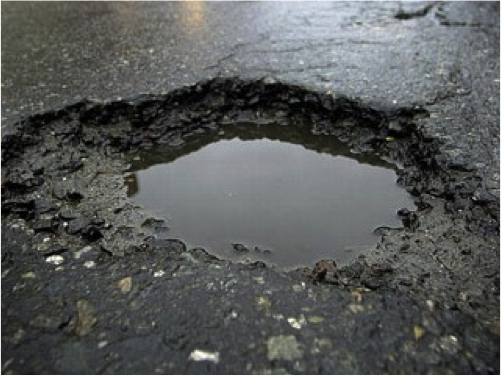Damaged, uneven, and decaying asphalt surfaces are a persistent challenge for communities everywhere. Maybe it’s the rut near your home that forces you to swerve every morning. It could be the bad pot hole in the parking lot at work that you usually avoid, until it knocks your steering out of alignment. Then there’s the quicker route to the grocery store, but only if you can successfully navigate the maze of cracks and ruts.
Admittedly, these are first world problems. Most likely, you are opting to drive when you could walk and enjoying climate controlled heat or AC while you dodge those pesky potholes. The fact remains though that we spend considerable time and effort navigating problematic roads daily.
How much damage do potholes do to your car?

The cost of not repairing roads is staggering. In fact, in 2016, the American Automobile Association estimated that 16 million drivers had their cars damaged by potholes. The damage included tire punctures, bent wheels, and damaged suspension.
Even more serious, experts estimate that poor road conditions cause one-third of all car accident fatalities. This includes poorly maintained roads. While we can’t control all road conditions, we can repair our roads.
You might ask exactly how you can repair your roads. Stretching a road repair budget to meet the asphalt maintenance needs of a community is a juggling act. Small communities with less tax revenue and lower budgets are particularly hard hit.
How do potholes form?

To fix your potholes for good, you need to learn the basic science behind how potholes form. The main factors in pothole formation are moisture and temperature fluctuations.
First, water enters the road surface through a small crack. It weakens the road base underneath the pavement. Traffic drives over the weakened road base. It breaks down the asphalt or chip seal roads, creating a pothole and damaging the pavement structure.
Temperature also plays a major role in pothole formation. In a warm climate, temperature fluctuations cause the pavement to expand and contract. Intense heat and sunlight can also make the asphalt more brittle and prone to cracking. When you combine this with heavy moisture weakening the road base and traffic on the road surface, the result is a pothole.
In a cold climate, the freeze and thaw cycle further exacerbates the situation. Water seeps into the road base, and as the base freezes with cold temperatures, it expands. When warmer temperatures return, it contracts. This weakens the road base so that it can no longer support the pavement, and, you guessed it, potholes form.
What is the best way to repair potholes?
Most communities resort to some form of pothole patching for their asphalt road maintenance to extend the life of the pavement. Unfortunately, even with a road patch, the same potholes return on the asphalt or gravel road.
This is because pothole patching equipment doesn’t address road base repair or water drainage issues. When you don’t address road stabilization, the potholes come back again and again. Pothole patching is initially inexpensive with road patching equipment. Unfortunately, the cost savings diminish when you repeatedly repair the same section of road.
The best way to repair potholes is through a process called full depth reclamation or FDR. Full depth reclamation uses a piece of equipment called a road reclaimer. A large rotating drum mounted with cutting teeth pulverizes the road surface into reclaimed material. At the same time, it blends it with the road base.

The recycled asphalt millings, or reclaimed asphalt pavement, stay in place and act as road base material. Next, road grading allows you to control water drainage and helps prevent future road base failure. After compaction and paving, the road is ready for traffic.
Recycling materials allows high quality and eco friendly road repairs. Addressing more than the surface layers of road repair creates long-term repairs. Reusing pavement layers as road base also has a positive environmental impact.
A road reclaimer can perform asphalt pulverization at depths of up to 12 inches. Road reclamation and road base stabilization is the solution to pavement rehabilitation because it fixes the road base. You can perform asphalt reclamation on anything from a small pothole patch to a full city block. For more information on the full depth reclamation process, read this blog post.
How can my community afford a reclaimer machine?
Purchasing a self-contained asphalt reclaimer for pavement reclamation might be too expensive for a smaller community. Contracting out a full depth reclamation project can also be cost-prohibitive.
A less-expensive alternative, portable road reclaimers allow communities of all sizes to bring road reclamation in-house. They are also more versatile. A work truck can tow a portable reclaimer to the jobsite. It quickly connects to the backhoe or loader you already own.
Communities regularly report huge cost and time savings on road repairs using their asphalt reclaimer. In fact, they can do in a day what used to take two weeks. They also report saving approximately 70% compared to contracting out for the same project.
In some states, there are local road grants that can pay for the full or partial cost of an asphalt reclaimer. Check with your DOT to see what may be available in your state. 5-year payment plans are also an option that spread the cost of a road reclaimer out over five years. Many towns say that the money they save on road repairs in the first year pays for the road reclaimer.
You can’t afford not to own a road reclaimer.
With proper road repair equipment, it’s possible for even a small community to reclaim their roads. By repairing not just the pothole but the failing base underneath it, they enjoy smooth roads for years to come. This is all accomplished through versatile portable road reclaimers.